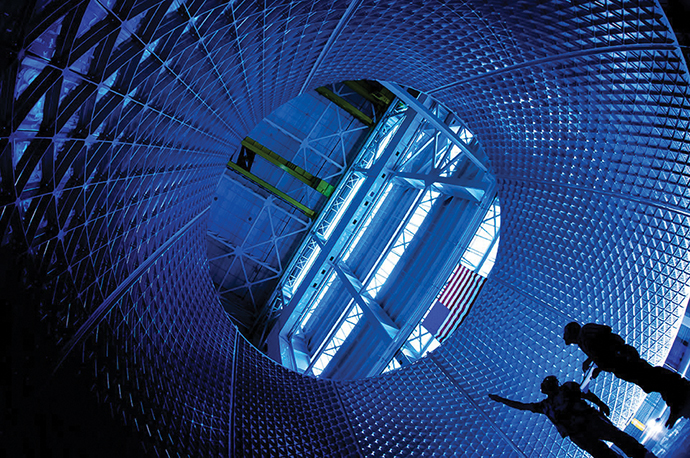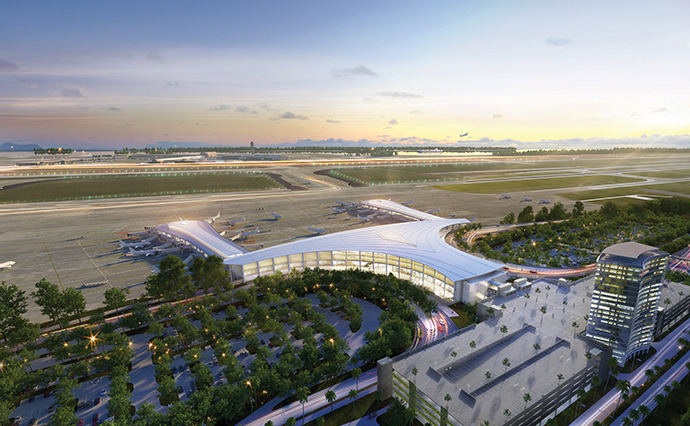The website for Louis Armstrong New Orleans International Airport can be found at flymsy.com. But there’s nothing flimsy about its growth. Indeed, the flight trajectory of the facility and its Louisiana brethren could finally help the state live down one particular departure that happened 75 years ago, when Delta Air Lines — one year after introducing Coca-Cola on its flights — followed the trail of bubbles from its hometown of Monroe to a new headquarters in Atlanta.
Called MSY because it was located near the Moisant Stock Yards, named for famed barnstorming aviator John Moisant, the airport saw its passenger count jump by more than 9 percent in 2015 to a record 10.6 million passengers, who, the airport says, enjoyed nearly a quarter million beignets. Year-to-date numbers this year already are up by 4 percent, in what could be the airport’s seventh straight year of growth. Since January 2015 the airport — where the most frequently asked question is “Can I bring a king cake on board the aircraft with me?” — has seen airlines add 17 new flights.
The newest may be the most meaningful in terms of international connectivity. In June, Frankfurt, Germany–based tourist airline Condor launched twice weekly seasonal service between Frankfurt and New Orleans, marking the city’s first non-stop flight to Europe since the 1980s. Frankfurt (FRA) is Europe’s fourth-busiest airport, and Germany ranks second in its level of foreign investment projects in Louisiana. Germans are also known for their generous vacations, with an average break lasting 13 days.
“This will strengthen our historical ties with Europe and improve efficiency for both Louisiana and European businesses, particularly in the petrochemical industry,” said Michael Hecht, president and CEO of Greater New Orleans, Inc. before invoking words reminiscent of another famous Armstrong: “The establishment of non-stop air service between New Orleans and Europe fulfills a top priority for our region — it is one new flight for our airport, but one giant leap forward for post-Katrina Louisiana.”
“We are very pleased to introduce this new link between New Orleans and Frankfurt, giving Louisiana and Mississippi and other states in the South a unique choice for their travels to Germany,” said Jens Boyd, group head of long-haul at Condor. “And with our numerous partner airlines we offer flights beyond Frankfurt to over 120 destinations across Europe at very competitive prices. Furthermore, New Orleans, as the birthplace of jazz, is a very attractive destination for European tourists, and we also will stimulate traffic from this direction.”
The airport also recently added an Air Canada flight to Toronto and a non-stop to Panama City, Panama, from leading Latin American airline Copa. Hecht expanded on the importance of the new links in a letter to stakeholders, calling international flight connectivity a top priority for GNO. “In a global economy, you are either global, or you are not,” he wrote. “We believe there is little we can do that will have greater systemic impact than more flights to more places.”
Proving the Thesis
That’s nearly a verbatim statement of a concept propounded by an associate professor of finance at the MIT Sloan School of Management with the very Louisiana-sounding name of Xavier Giroud, who has studied for a number of years the impact of direct and indirect flights. His latest co-authored study — based on 30 years of flight, patent and VC data involving nearly 23,000 startups that worked with more than 3,000 venture capital firms — aligns even more with the thrust of New Orleans’ startup vibe. It shows that venture capitalists help startup firms by closely monitoring their development, and that the availability of direct airplane flights between the two parties helps improve that oversight by leading to more patents and spinoff.
“The effect is that those companies become more innovative,” said Giroud in a press release in February 2016. A separate survey of 306 VC firms found that 86 percent of the respondents agreed that direct flights allow them to spend more time monitoring the firms in their portfolios. The study also found a wider dispersion of both startups and VCs than one might think, with about 50 percent of startups and VCs in the study located outside of the traditional hot spots of Northern California, New England, and New York. And those firms with those direct flights are also slightly more likely to exit successfully or undergo an IPO.
“There are entrepreneurial firms all over the place,” said Giroud. They might as well be in New Orleans too.
The findings build on research Giroud published five years ago, when he combined plant-level data with airline data in the US from 1977-2005 in order to analyze how the introduction of new airline routes affected plant investment. It turned out that a new direct route led to an increase in plant investment of 8 percent to 9 percent. Further, he found that plants’ total productivity increased by up to 1.4 percent.
“If your managers are very close — or can easily travel to your plant site — then they can learn more about your plant and supervise you more, leading to increased investment and productivity,” Giroud told Site Selection.
Complementary research published in June 2015 by researchers at MIT’s Laboratory for Aviation and the Environment (LAE) analyzed flight schedules between 1990 and 2012 from more than 1,100 airlines connecting over 4,600 airports around the world. They also looked at 1.2 million tickets to gauge passenger behavior in order to learn to what degree regions around the world are connected via air transportation. They found that while the US was the clear connectivity leader in 1990, by 2012, airports abroad had grown their flights enough to increase the links between world regions by 140 percent, including those crucial connections business travelers run to make.
“The study shows that connectivity is growing, and an important implication is that it will continue to grow,” said Jan Brueckner, a professor of economics at the University of California at Irvine. “A policy implication of the study concerns the benefits of international airline alliances, whose ability to stimulate connectivity should be appreciated and fostered by regulators.”
The international airport infrastructure of Louisiana includes what its managers call “America’s Premier Industrial Airport” at Chennault International Airport in Southwest Louisiana. The region in June welcomed news that LACC LLC, a joint venture of Lotte Chemical and Axiall Corp., will build a $1.9 billion ethane cracker complex near Axiall’s existing manufacturing plants in Calcasieu Parish. Using a portion of ethylene produced by that plant, Lotte Chemical will produce monoethylene glycol at a $1.1-billion plant constructed beside the ethane cracker.
Many Modes
Connections don’t just happen through the air. Railways and waterways have roles to play as well. And so does space.
In May, Port Cameron, LLC announced it will develop a new $1.5-billion deepwater staging port in Cameron, Louisiana, located on the Calcasieu Ship Channel, some three hours east of Houston and just south of Lake Charles, and less than an hour by highway south of I-10. According to an economic impact study by Louisiana-based economic consulting firm Loren Scott Associates, when fully leased, activity at the port will create approximately $2.8 billion in sales and about 10,000 jobs for the State of Louisiana.
This summer, multinational railroad concern Kansas City Southern announced that its Meridian Speedway joint venture with Norfolk Southern is investing approximately $28 million in 2016 on construction and improvement projects on its Vicksburg and Meridian Subdivisions. Meridian Speedway LLC is a 320-mile rail line between Meridian, Miss. and Shreveport, La., offering end-to-end steel wheel interchange for intermodal customers.
In Louisiana, KCSR owns and operates approximately 915 miles of rail infrastructure and serves the river ports of Baton Rouge, Lake Charles and Natchitoches and the Gulf port of New Orleans. KCSR serves several transload facilities in the state.
Gov. John Bel Edwards recently announced new Louisiana-based operations for the French America Line, the consumer-facing name of Great Northern & Southern Navigation Co., which is establishing a new headquarters at the former Gretna ferry terminal in Jefferson Parish. The terminal will serve as the home port for the company’s deluxe 150-passenger vessel Louisiane, scheduled to launch in September 2016. French America Line will offer five- to 10-day boutique cruises on the Mississippi, Ohio, Tennessee, Cumberland and Red rivers, with stops at major cities along the way.
French America Line will create 94 new direct jobs with the project, with 64 of those jobs aboard the Louisiane and 30 shore-side positions for both French America Line and Uncommon Journeys, its sales and reservations partner.
Michoud? Bless You.
It’s going to take big spaces and big ideas to deliver humans to deep space. Pay a visit to NASA’s Michoud Assembly Facility in New Orleans, and you’ll see plenty of both, as the facility welds its space program heritage to a future that goes beyond the moon. On the same former sugar-cane fields where the Saturn V rockets for the Apollo missions and the Space Shuttle’s external fuel tanks were constructed, work continues toward the planned 2017 inaugural flight test for the Space Launch System (SLS), described by NASA as “the most powerful rocket ever built that will take American astronauts into deep space, first to an asteroid beyond the moon and eventually on to Mars.”

Michoud has a $540-million impact on the local area in Louisiana and Mississippi, and supports roughly 5,400 jobs. “NASA does not have huge budgets like back in the 1960s,” Bobby Watkins, director of Michoud, told Site Selection last fall. “We try to leverage taxpayer dollars to the best of our ability” while also providing access to Michoud’s extensive assets in order to help those tenants be successful. “I’ve challenged my team to look at our current tenant base and increase it by 20 percent by this time next year.”
Large-scale manufacturing is the primary target, encompassing such sectors as aircraft, automotive and shipbuilding. The 300 acres (121 hectares) of available greenfield are available for an enhanced use lease, similar to leases companies have pursued on military bases under BRAC.
In addition to the SLS work, Michoud is home to the UK’s Blade Dynamics, a maker of huge composite blades for wind turbines that was just purchased by GE. In July 2015, Michoud shipped a 78-meter blade, the largest wind turbine blade ever manufactured in North America, from the port on site to Germany where it’s being tested. Other Michoud tenants include DNV (Det Norske Veritas); the US Coast Guard; Textron Land & Marine Systems; and Alabama-based B-K Manufacturing. The USDA’s National Finance Center at Michoud provides data center hosting, help desk support, human resources, and payroll services, processing a payroll of $1.7 billion for approximately 640,000 federal employees in 170 government agencies every two weeks. NFC employs approximately 1,000 full-time positions (not including subcontractors).
Finally, Michoud is home to Big Easy Studios, founded after Katrina by Herbert W. Gains and New Orleans entrepreneur Jerry Lathan. Among the films made at Big Easy are “GI Joe II,” “Ender’s Game” and “Jurassic World.” The investment came just as the winding down of the Space Shuttle program was leaving enormous spaces at Michoud unused.

